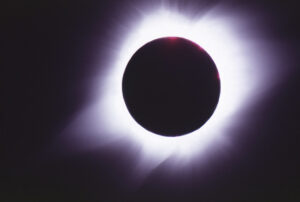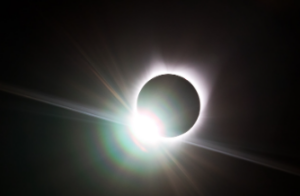
Period of totality during a total solar eclipse
Stargazers and astronomy lovers, get ready for a once-in-a-lifetime total Solar eclipse! On April 8th, 2024, the skies will darken across the USA as this spectacular occurrence makes its way from the southern reaches of Texas all the way up and across the East Coast! We’ve gathered all the information you need to prepare for this exciting, can’t-miss celestial event.
What is a Total Solar Eclipse
Chances are you’ve heard of a partial solar eclipse, where the moon passes between the sun and Earth, causing a shadow that covers a portion of the sun’s disc. While really cool, these partial eclipses are quite common, occurring on average twice a year. A total eclipse, however, where the moon blocks out the entirety of the sun from our view, only happens once every eighteen months on average, making it a less common occurrence.
What Makes the Upcoming Total Eclipse Special?
Total solar eclipses in themselves aren’t a once-in-a-lifetime experience, so why is everyone so excited about the one occurring on April 8th, 2024? The difference is that this time, the eclipse isn’t confined to a specific area; instead, it will make its way coast to coast across North America. That means people in Mexico, Canada, and the United States have the opportunity to witness this unique event. It’s so rare for an eclipse to travel this far that it only occurs approximately once every 100 years. Now that’s cool!
What Happens During a Total Solar Eclipse?
A total solar eclipse is one of the most unique experiences you will ever witness, and it can feel quite surreal. Since the moon comes between the Earth and the sun, an act known as the path of totality, it temporarily blocks the light, casting a massive shadow over the entire viewing area. When this happens, it becomes dark outside despite it being daytime. The temperatures drop just as they do at night, and often, nocturnal animals will emerge thinking it’s time to wake up. The sun’s outer atmosphere, called its corona, which is usually obscured by its brightness, will also become visible.
The Stages of a Total Solar Eclipse
The total solar eclipse happens in stages, and each part is exciting to witness.
Partial Eclipse – It starts with a partial eclipse, where the sun takes on a crescent shape, similar to one of the moon’s phases. The partial eclipse lasts anywhere from 70 to 80 minutes from the first point of contact.
Shadow Bands – Shadow bands are one of the coolest parts of the eclipse, but they’re hard to spot if you don’t know when to look. These long, dark, rapidly moving bands appear on the ground and along the sides of buildings right before and after the point of totality. Shadow bands occur due to turbulent air cells in the upper atmosphere that distort the typically razor-sharp edges of light. A similar phenomenon happens to starlight, causing stars to have their twinkling appearance.
Baily’s Beads – Bailey’s Beads are the third stage of the total solar eclipse, but they happen so quickly that if you blink, you may miss them. As the moon moves across the sun’s path, points of light appear around its edges. These rays illuminate the moon’s surface, highlighting its mountains and valleys. Due to how fast this stage can occur, it may not be visible to many observers, but for those who do see it, Baily’s Beads are a beautiful spectacle to behold. Do you think you can spot them?
Diamond Ring – Following Baily’s Beads is the Diamond Ring. This stage got its name from the singular bright spot that appears along the moon’s edge, resembling a diamond. Once this stage occurs, totality is near, so keep watching!

Diamond ring effect taking place during a total eclipse of the sun
Totality – Finally, what everyone is waiting for, the moon will fully move in front of the sun, completely blocking its light. Totality, also called second contact, is the only part of the eclipse where it is safe to take off your safety glasses and look with your naked eye. During this time, you may be able to spot the corona and the chromosphere, a thin pink circle of the solar atmosphere that appears around the moon. While the world darkens, take a moment to look around; you might see a 360-degree sunset, along with bright planets and stars in the sky. You may also notice everything sounds eerily silent as the temperature drops. Totality only lasts one or two minutes, so be sure to quickly put your safety glasses back on before the first hint of sunlight appears.
Following totality, all the stages will happen again in reverse, so if you missed them the first time, you have a second chance to see them again.
Total Solar Eclipse Safety
While beautiful, you should never look at a solar eclipse without specialized safety glasses. Since the moon makes the sun appear less bright, it’s tempting to try to look at it with the naked eye, but doing so will result in instant severe eye injury. You can purchase a pair of solar eclipse glasses or a special solar viewer to enjoy this spectacular event safely.
Who Can See the Total Solar Eclipse
While not visible to all of North America, those in specific locations will be lucky enough to witness this once-in-a-lifetime event. A few cities in the path of the eclipse include:
- Sherbrooke, Quebec, Canada
- Ironton, Missouri
- Niagra Falls, New York
- Carbondale, Illinois
- Erie, Pennsylvania
- Radar Base, Texas
- Cleveland, Ohio
- Indianapolis, Indiana
For a more extensive list of cities within the total solar eclipse path, click here.
You won’t want to miss this breathtaking event that won’t happen for another 100 years. Be sure to use the proper eye protection so you can safely enjoy the beauty of this total solar eclipse. For more information and exciting resources, check with Solar Sam, our official total eclipse ambassador!
